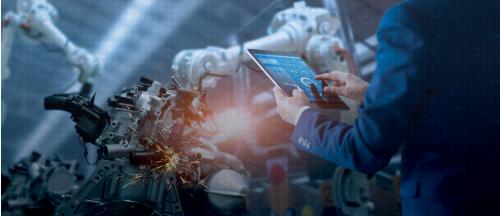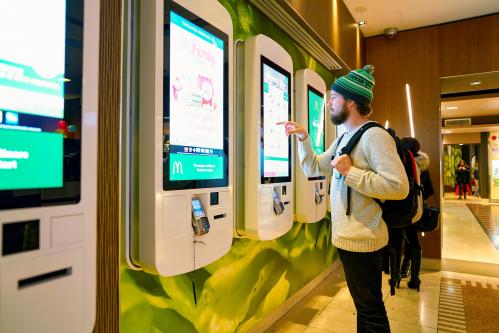If economic anxiety is a factor in the nation’s backlash politics, the spread of automation is likely an important context for understanding it.
Economist Jed Kolko has explored this link with federal data organized to map the geography of “routine” jobs most at risk of automation. Additionally, the economist Carl Benedikt Frey and his colleagues conclude that “automation in recent years tilted the electorate into opting for radical political change.”
Which raises the question: What do Brookings’s new automation and artificial intelligence (AI) data and analyses say about the nation’s tense political geography?
Derived from assessments of occupations’ automatability provided by David Autor and McKinsey Global Institute, our analyses are based on quantifications of the likelihood the current task mix of hundreds of occupations could be automated with current technology. As such, our numbers estimate occupational vulnerability and, essentially, worker precariousness or anxiety about the future—hence their political relevance.
What do our data show? Our data confirm both a stark history of automation in Trump country and substantial future exposure—exposure that points to more work flux, more job uncertainty, and potentially more political disruption.
Along these lines, while our backward-looking look at of “routine” job concentrations and work disruption clearly points to parts of the 2016 backlash map, our forward-looking analyses of automatability makes the link even more tightly.
At the state level, all but one of the ten states most heavily exposed to future job market changes cast its electoral votes for President Trump in 2016.

Specifically, Heartland states like Indiana and Kentucky, with heavy manufacturing histories and low educational attainment, contain not only the nation’s highest employment-weighted automation risks (48.7 and 48.2 percent of tasks vulnerable to replacement, respectively), but also registered some of the widest Trump victory margins. By contrast, all but one of the states with the least exposure to automation, and possessing the highest levels of educational attainment, voted for Hillary Clinton, perhaps reflecting greater comfort with tech trends that have most benefited these same states. The strong association of 2016 Electoral College outcomes and state automation exposure—leaving aside questions of deeper causality—very much suggests that the spread of workplace automation and associated worker anxiety about the future may have played some role in the Trump backlash and Republican appeals.
Turn now to the 2018 midterm election, and it’s clear that the finer-grained evidence of congressional district voting reinforces the impression of automation-driven job precariousness and Republican voting. To be sure, no single factor such as tech-driven worker anxiety determines local political behavior. But there’s no mistaking that districts that voted Republican in the 2018 election are subject to higher levels of automation exposure, reflecting GOP voters’ lower education levels and higher involvement with factory, transportation, and lower-skill service-sector jobs.
No single factor such as tech-driven worker anxiety determines local political behavior. But there’s no mistaking that districts that voted Republican in the 2018 election are subject to higher levels of automation exposure.
The average automation potential of Republican districts is now 47.5 percent of all tasks compared to the 44.7 percent figure for Democratic areas—revealing a modest but noticeable gap that also reflects Republican dependence on higher-exposed smaller towns and rural communities in the Heartland.
Such places in general tend to have lower education levels and greater relative exposure to manufacturing, transportation, or other “routine” activities.

With that said, the party contrast on automation exposure becomes much more dramatic when we look at the range of individual congressional districts’ levels of susceptibility. Now the differences look much larger than they did across states or in aggregate. Specifically, only 4 of the 50 most automation-exposed congressional districts are represented by Democrats, while every one of the 50 least-exposed districts is represented by Democrats.

What’s more, the differences of automation risk across geography and community type are revealing. The 10 least-exposed congressional districts to automation driven task displacement include big, Democratic high-tech and professional-services oriented districts as Virginia’s 10th and 11th districts (covering Arlington and Fairfax counties in the northern-Virginia tech hub); New York’s 8th, 9th, 10th, 12th, 13th, and 15th districts around New York City; and California’s 19th district encompassing much of Silicon Valley. Other low-exposure districts around the country include Massachusetts’s 7th reaching into downtown Boston, Colorado’s 6th in suburban Denver, and Pennsylvania’s 3rd in central Philadelphia.
By contrast, the most automation-exposed districts in the country include rural or small-town districts such as Alabama’s 4th district; Georgia’s 14th; industrial and nearby rural locations like Indiana’s 2nd and 4th districts or northern Ohio’s 4th, 5th, and 7th districts; and the agricultural area of Wisconsin’s 7th district. Other high-exposure Republican-voting districts include political backlash examples such as Iowa’s 2nd in the southeastern part of that state and Minnesota’s 1st, south of the Twin Cities.
The story told by congressional-district voting very much confirms that jurisdictions exposed to the most automation-based dislocation are some of the most likely to vote Republican. To be sure, as Jed Kolko has noted, it’s nearly impossible to fully disentangle automation from other economic and demographic factors, because “demographic characteristics and economic conditions are themselves related.” But even so, it is clear that to the extent that places experiencing high automation threats are experiencing greater economic stress, that stress is a factor in their voting behavior.
Which suggests two takeaways. One is that automation, and the worker anxieties associated with it, appears to be a subtle, real, and far-reaching factor in voting behavior that may be triggering even more anxiety in red America than blue America, with more stress to come. Such trends underscore the importance of problem-solving to help mitigate the transitions ahead and suggest that it would behoove the presidential candidates to begin describing their responses.
The second takeaway is that while the two Americas are experiencing somewhat different trends, automation is impacting both realms, with large pools of lower-skilled production, transportation, service, and clerical workers at risk across red-blue lines. That means there may be room and reason for cross-party cooperation on efforts to facilitate smoother transitions and reducing hardships for displaced workers and communities affected by automation.
Appendix of average automation potential by congressional district is available to download here.
The Brookings Institution is committed to quality, independence, and impact.
We are supported by a diverse array of funders. In line with our values and policies, each Brookings publication represents the sole views of its author(s).









Commentary
Automation perpetuates the red-blue divide
March 19, 2019